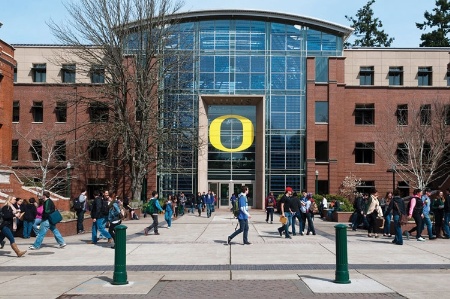Source: Corbis
Debtors’ prison: total US student loans have passed the $1 trillion mark. Pay It Forward is attempting to offer an alternative
The American social compact may be under siege, with conservatives deriding the idea of underwriting other people’s healthcare and insisting that government spending be cut. But a proposal that graduates pay for the university educations of the students who come after them is gaining unexpected traction.
The idea, Pay It Forward, was formulated by a Seattle thinktank and may soon be tested in the nearby state of Oregon. Legislation to follow suit is under consideration in at least 10 of the other 50 US states.
The idea would make public universities tuition-free for students who agree to pay a portion of their incomes post-graduation into a fund that would support the education of successive generations.
Detractors say that the numbers do not add up and that Pay It Forward is really just another tax or loan – two of the most vilified terms in a nation deeply divided over how much tax should be paid and by whom, and where total student loan debt has surpassed the seemingly implausible $1 trillion (£621 billion) mark.
Advocates say that while the idea is modelled on the income-based repayment systems in the UK and Australia, Pay It Forward is not a loan, because graduates are not required to repay a predetermined amount. Rather, they would pay a specified percentage of their earnings over a given number of years.
A fair measure
The argument is that this is a fair way to reimburse the state for a service that enhances recipients’ net worth. And it seems to be making inroads with those looking for an alternative to skyrocketing tuition costs and falling public support for higher education.
“Anything that we can do to work on the issue of access and affordability is important,” says Sam Dotters-Katz, president of the student government at the University of Oregon.
In Oregon, legislators have approved a study of the idea and are considering a pilot programme that would begin in 2015. Similar legislation has been proposed or is under deliberation in at least 10 other states: Illinois, Maine, Maryland, Massachusetts, Michigan, New Jersey, Ohio, Pennsylvania, Vermont and Washington. The approach is also being discussed in California and Texas. And one US senator has urged that federal money be allocated to get things started.
“They realise that the current system is broken and that this is an interesting out-of-the-box paradigm shift in terms of higher education access,” says John Burbank, executive director of the Seattle-based Economic Opportunity Institute, the liberal thinktank that formulated the idea.
“A lot of state legislators are middle class themselves: they’re looking at tuition for their kids and are in the same bind as everyone else.”
Critics say that this desperation for a solution has made Pay It Forward seem more appealing than it actually is. They argue that it would encourage states to continue the trend of putting more of the burden of higher education costs on to students and their families. And they claim that students planning careers in higher-paying fields would refuse to take part, knowing that they would end up contributing more of their incomes than fellow graduates in lower-paying jobs.
Under the scheme, graduates would pay 0.75 per cent of their post-tax income into the fund for every year they were at university over a set period of time. A student who received a degree in four years, for example, would pay 3 per cent of their earnings for 24 years after graduation.
The proposal’s backers say that this prospect would not necessarily compel students in high-income majors to go elsewhere. They argue that the lure of free education is stronger than concern about future obligations, especially for young adults about to enter university.
“When you’re 18, you have no idea how much money you’re going to be making 10 years in the future. You do know how much tuition is going to be next year. And if the choice is between zero or $12,000, zero looks pretty good,” Burbank says in a reference to the approximate annual cost of tuition at public universities in the state of Washington.
“People don’t really take that longer view of long-term earnings; they look at the expense coming up next year. In that sense, Pay It Forward is really beneficial.”
Dotters-Katz agrees. “For students, what’s important is getting in the front door,” he says. “It’s a luxury to worry about payroll deductions later on.”

Terms of engagement
Still, those deductions clearly make Pay It Forward a tax, according to Alex Holt, programme associate at the New America Foundation, a thinktank. “They’ve just shifted them from one part of the tax base to another.”
But Burbank wants to change the terms of the discussion.
“If we want to get people to think of this as a new paradigm, it doesn’t help to call it a tax or a loan,” he says. “It’s more of a social insurance system.”
However, high earners would end up paying more than the actual cost of their educations, estimates have shown, compensating for the lower incomes of graduates in less lucrative fields. And if they do decide to avoid this by abandoning public universities for private ones, the rate levied on everyone else would have to be increased.
“If the good risk leaves the pool, you’re stuck with a bunch of people whose repayment will fall short of what’s needed,” Holt says. “And if you increase their rate, even more people will defect. That’s what in insurance is called a death spiral.”
Another problem: how do you collect from graduates who leave the states where they studied – and how do you determine their earnings?
“Even if the federal government gave them access to these people’s adjusted gross incomes, there’s still the issue of how aggressive the state of Oregon is going to be to get back this money,” Holt says. “This really has the potential to fall apart when it comes to the details.”
Early estimates show that getting the scheme started would be extremely expensive. In Washington, for instance, it would take 25 years for the initiative to start paying off, during which time it would cost the state $35 billion.
In the meantime, the state would have to borrow money to keep its universities afloat, and people who have studied the concept say that its formula does not fully take into account the cost of interest.
“This is not a self-sustaining programme. It will cost money. And it’s going to have to come from taxpayers,” Holt says.
National conversation
Pay It Forward may address, to some extent, the issues that have allowed colleges to push up costs with such impunity until now. Universities would be forced to live within their means, since their budgets would be limited to a specific percentage of their graduates’ income: there would be no tuition fee to raise and no state allocations to increase.
In that regard, the concept has started a national conversation about new ways to pay for higher education, Burbank says.
“Americans may be suspicious of progressive income tax, but when it comes to something that they can see creates an immediate benefit for them or their children, and they see that everyone’s paying into it and everyone’s getting something out of it, then they get it,” he adds. “It’s a real shift in culture.”
Wishful thinking, responds Holt.
“It’s troubling how quickly states are saying: ‘Oh, this seems like a good idea,’” he says. “Any time it seems like you’ve found a way for things to cost people less money, it’s probably not true. It is probably always going to cost the same amount. You’re just moving the money around.”
Register to continue
Why register?
- Registration is free and only takes a moment
- Once registered, you can read 3 articles a month
- Sign up for our newsletter
Subscribe
Or subscribe for unlimited access to:
- Unlimited access to news, views, insights & reviews
- Digital editions
- Digital access to THE’s university and college rankings analysis
Already registered or a current subscriber?




